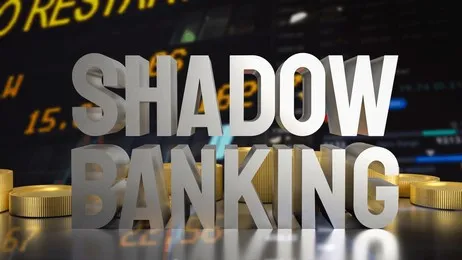Shadow banking refers to the system of financial intermediaries that conduct credit intermediation activities outside the traditional banking sector. These non-bank financial institutions and markets provide credit and other financial services without being subject to the same regulatory oversight as traditional banks. While shadow banking can offer more flexible and cost-effective financial services in certain areas, it also poses risks to the financial system.

Participants in the shadow banking system may include:
- Hedge Funds: These private investment funds typically operate without traditional banking regulations and may employ high-risk strategies to achieve returns.
- Money Market Funds: These funds offer investors short-term investment products, usually consisting of corporate bonds, treasury bills, or other short-term debt instruments.
- Investment Banks: Although regulated in some respects, certain activities of investment banks, such as securitization and other structured finance activities, are often considered part of shadow banking.
- Special Purpose Entities (SPEs) or Special Purpose Vehicles (SPVs): These entities are frequently used in securitization and other offshore financial operations and are usually not subject to banking regulations.
- P2P Lending Platforms: These online platforms directly connect borrowers and investors, bypassing the traditional bank loan process.
- Private Equity and Venture Capital Funds: These funds invest in the equity of unlisted companies and do not accept public deposits, thus typically not falling under banking regulations.
- Finance Companies: These companies provide credit services such as consumer loans or leasing services but do not accept public deposits.
- Trust Companies: In some countries, trust companies can offer services similar to those of banks but do not accept traditional deposits.
Risks Associated with Shadow Banking
- Regulatory Arbitrage: Shadow banking entities may exploit regulatory differences across countries and regions to evade stricter financial oversight.
- Lack of Transparency: The transparency of shadow banking activities is often lower than that of the traditional banking system, making it difficult for regulators and market participants to assess systemic risks.
- High Leverage: Some shadow banking institutions may use high leverage, increasing their vulnerability to market volatility.
- Liquidity Risk: Much of the funding in shadow banking is short-term, which can lead to liquidity shortages, especially under market stress.
- Interconnectedness: There are significant interconnections between the shadow banking system, the traditional banking sector, and other financial markets, facilitating the spread of problems throughout the financial system.

After the global financial crisis of 2008, there has been increasing international focus on regulating the shadow banking system to mitigate its threats to global financial stability. Despite these concerns, shadow banking remains a vital component of the global financial system, providing liquidity and credit to the market. In certain markets and areas, its presence is indispensable.
(Images from the internet)





